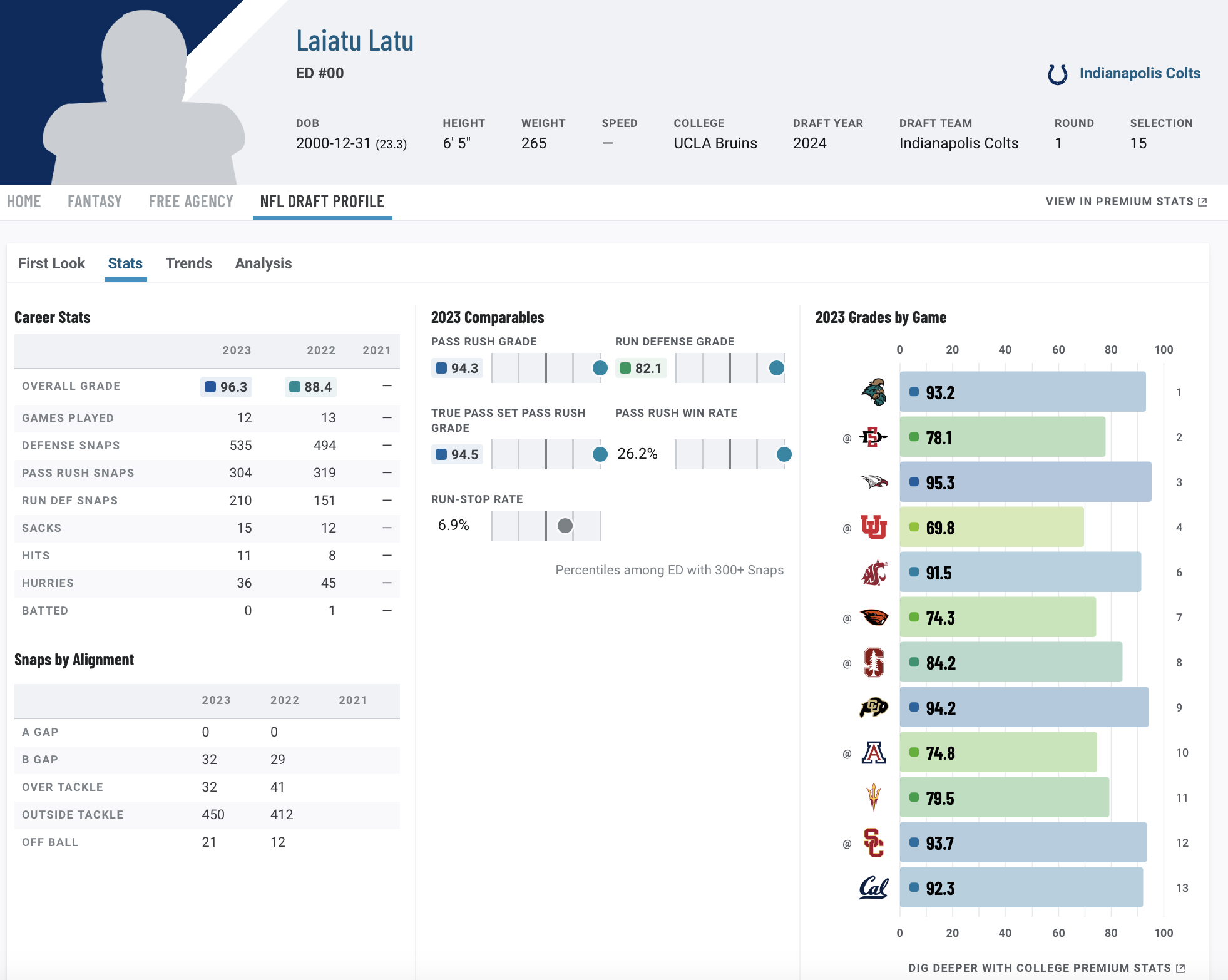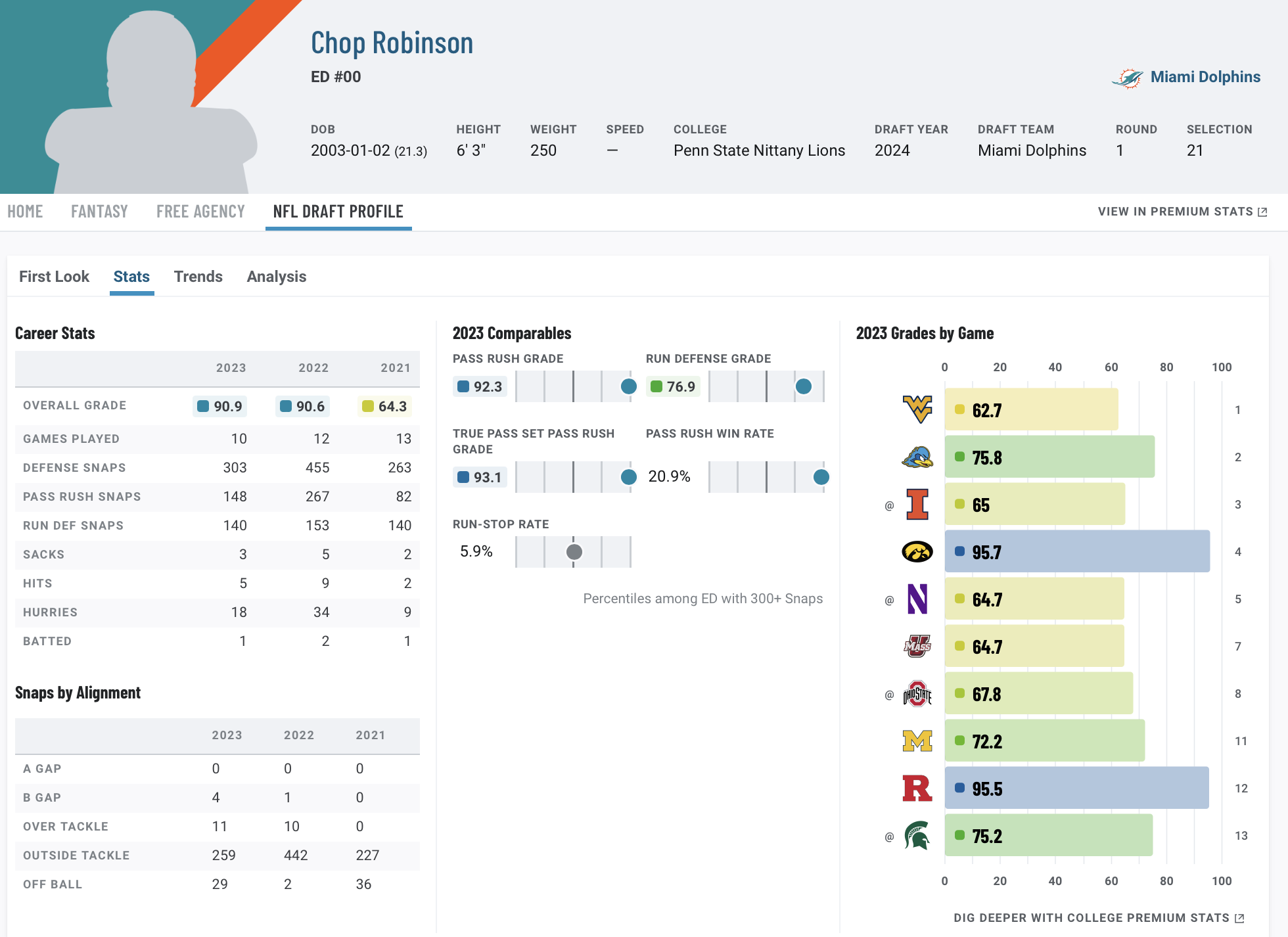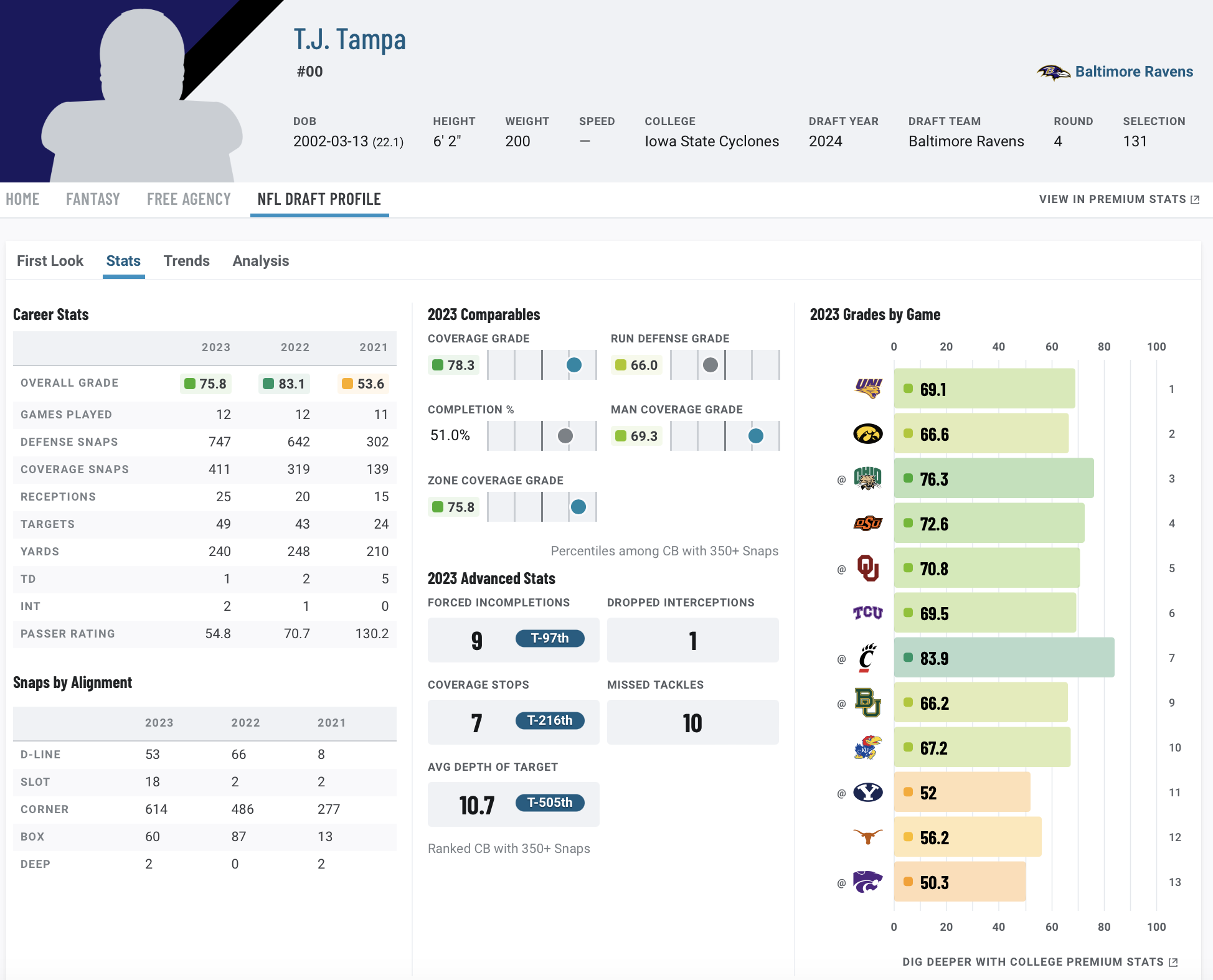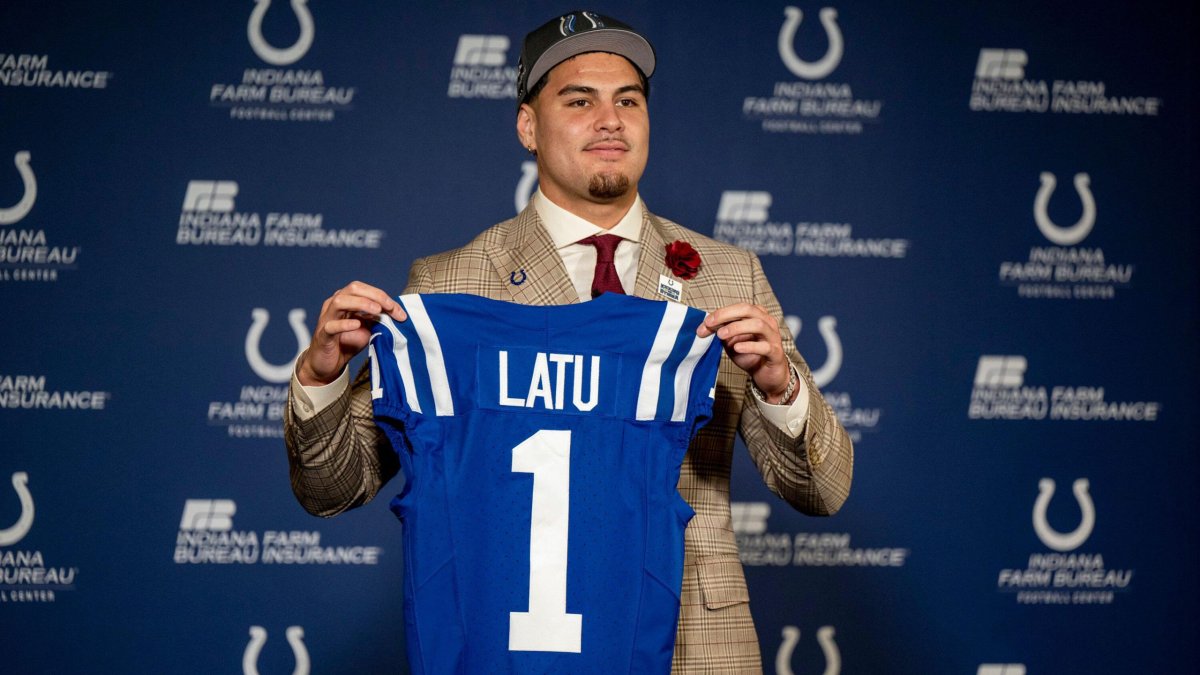• Colts secure a top-tier draft class: Laiatu Latu and Adonai Mitchell represent excellent value selections and provide tremendous upside.
• The Eagles continue to dominate drafts: As has become tradition, general manager Howie Roseman expertly navigated the draft and ended up with players such as Quinyon Mitchell and Cooper DeJean.
• Draft and trade for yourself: Try PFF's Mock Draft Simulator — trade picks and players and mock for your favorite NFL team.
Estimated Reading Time: 10 minutes
Click here for more draft tools:
2024 Mock Draft Simulator | 2024 Big Board | 2024 Draft Guide
2024 Player Profiles | 2024 Mock Drafts | NCAA Premium Stats
The NFL draft is one of the most fun times of the year, and even though we all know you can’t really judge a draft until years down the road, you can at least get an idea of how good the process was relative to consensus expectations and cost.
And everybody loves a little bit of validation.
So here are my 10 favorite draft classes from the 2024 NFL Draft.
I have factored in the value of players selected, whether anything glaring was left on the table, the trade collateral used to secure the players and so forth.
Indianapolis Colts
The Colts could have left the computer to auto-draft for them after Day 1 and I still would have liked this draft.
Getting Laiatu Latu with the 15th overall pick is an outstanding move. If his neck was cleared medically, he has a prospect production profile that puts him above the likes of Will Anderson Jr. and Aidan Hutchinson, and trailing only players like Myles Garrett and Nick Bosa.
Latu earned a 96.3 PFF grade last season, and the Colts of all teams selecting him shows that they buy into his elite athleticism.
Adonai Mitchell in the second round is also outstanding value. He has first-round talent, and though he has a little more work to do than some other receivers to hit his ceiling, the Colts can afford to let that play out. Tackle Matt Goncalves and center Tanor Bortolini are excellent depth additions, and receiver Anthony Gould could be a real weapon in the return game in addition to anything he can bring to the table as a receiver.

Philadelphia Eagles
What’s most remarkable about Howie Roseman's streak of fleecing the rest of the NFL in the draft is how he seems to do it by just sitting quietly and letting the draft come to him.
Quinyon Mitchell was the No. 1 cornerback on many people’s boards and the No. 12 overall player in the draft on the consensus board. The Eagles were able to secure him, at a position they desperately need to get younger at, at No. 22 overall. Mitchell is also a good fit for Vic Fangio’s scheme, given his experience with zone coverage. He didn’t allow a touchdown last season and had back-to-back years of 91.5-plus PFF grades.
Cooper DeJean was the No. 8 player on PFF’s big board, and even if you question whether he can play outside cornerback and is more of a projection to safety or the nickel, landing at No. 40 overall makes him a good value.
Jalyx Hunt is an elite-level NFL athlete who played at a comically low level in college, representing a really interesting developmental edge rusher. Will Shipley is a complete running back who should serve as a very nice backup to Saquon Barkley, and Day 3 was littered with great value picks, including linebacker Jeremiah Trotter Jr. and wide receiver Johnny Wilson.
Pittsburgh Steelers
For the second year in a row, the Pittsburgh Steelers had an outstanding draft. Their top two picks, Troy Fautanu and Zach Frazier, could each be Day 1 starters and upgrades along the offensive line. Fautanu, in particular, will free the team from needing to play Dan Moore Jr. against Myles Garrett twice every season.
Roman Wilson is one of the most NFL-ready receivers in this class. He averaged 2.68 yards per route run last season with just one dropped pass.
Payton Wilson slid into the third round due to an extensive injury history but has tape as good as any linebacker in this class and is an elite-level athlete. The Steelers securing him at No. 97 overall represents outstanding value.
Detroit Lions
Generally, trading up in the draft for non-quarterbacks is not a good idea. The uncertainty of player evaluation typically trumps anything a front office feels about a particular prospect. There is a degree of evidence, however, that players sliding from their position on the consensus board can represent value, and having a good feel of when to bend the rules is what has made this current Lions regime one of the best in the league.
Terrion Arnold was the top cornerback on the consensus board and the No. 11 player pre-draft. The Lions likely never considered a scenario where he would be within striking distance of their pick, so it’s tough to dislike trading to No. 24 to get him.
Doubling up at cornerback with Ennis Rakestraw Jr. in the second round is also an excellent hedge. They can coexist in the same defense, but there’s also a chance that the Lions were wrong on Arnold and Rakestraw becomes a better player.
Giovanni Manu is one of the few players PFF has no data on, but he has absurd athleticism and size and was getting a lot of buzz in the lead-up to the draft.
Mekhi Wingo has potential as an interior defender, and Christian Mahogany in the sixth round is one of the best value picks in the entire draft. He allowed seven total pressures in the past three years.
Miami Dolphins
I like Miami’s draft far more than most seem to. Chop Robinson was seen as a reach by many, but I think he belonged far closer to the top three edge rushers than he did the rest of this class. He put together consecutive seasons with a PFF grade above 90.0 and boasts an elite pass-rushing profile.
Patrick Paul was also largely viewed as a reach, but he is the second-tier developmental tackle I would have hitched my wagon to in this draft. Paul has some very questionable technique but the physical talent to win despite that. He posted at least a 91.1 PFF pass-blocking grade in each of the past two years, allowing two sacks total over that time. He got those results with poor technique; clean that up, and you have a star on your hands.
Jaylen Wright adds more explosiveness to an already comically explosive offensive group, and Malik Washington adds a true slot receiver to a far more vertically focused group.
Edge rusher Mohamed Kamara is one of the most explosive edge rushers in this draft and was selected at No. 158 overall in the fifth round.

Cincinnati Bengals
Tackle Amarius Mims went to a great landing spot in Cincinnati. The Bengals already have a pair of tackles on the roster (each also 6-foot-8 and 335-plus pounds), so Mims doesn’t need to start right away, but he can slot right in as Trent Brown’s heir apparent at right tackle and learn from a pair of players who know how to make it work at that size.
Kris Jenkins is a disruptive playmaker on the interior defensive line, particularly in the run game. He will go a long way toward replacing D.J. Reader, and even if the team reached for McKinnley Jackson in the third round, he has obvious physical traits to work with.
Receiver Jermaine Burton represents one of the biggest upside picks in the entire draft. Burton arguably has first-round tape but the kind of attitude profile that makes it hard to find anybody with a good thing to say about him. He goes to an already established locker room where, if he can keep himself on the straight and narrow, he could become the team’s second receiver after Tee Higgins eventually leaves.
Erick All and Tanner McLachlan can compete to make an impact at tight end, doubling the team’s chances of finding a contributor there.
Washington Commanders
I believe Drake Maye should have been the second quarterback off the board, but the gap between him and Daniels is so close that I don’t disagree with Washington taking Daniels instead. It’s simply which side they came down on in that close battle.
Johnny Newton is a steal in the second round, regardless of the fact the Commanders are far from needy at that spot. Newton tallied 43 pressures last season and a 15.4% pass-rush win rate while gaining extensive experience in NFL alignments rather than quirky college fronts.
Mike Sainristil should be an immediate plus player in the slot, and Ben Sinnott can be a receiving weapon at tight end right away.
Third-rounders Luke McCaffrey and Brandon Coleman, the lineman out of TCU, each have a chance to work their way onto the field.
Baltimore Ravens
Nate Wiggins has the coverage talent to be the best cornerback in this draft. A 4.28-second 40-yard dash won’t hurt his chances, either. Wiggins allowed just a 44.4 passer rating into his coverage last season, surrendering 18 catches all year.
Roger Rosengarten can potentially start from Day 1, and edge rusher Adisa Isaac brings some strength to the edge rotation.
Tez Walker at receiver and T.J. Tampa at cornerback in the fourth round is daylight robbery. Walker averaged 2.28 yards per route run last season with an average depth of target 18.2 yards downfield. He had a terrible Senior Bowl week full of drops but totaled only three drops last season for North Carolina.

New York Giants
The Giants reportedly tried to trade up for a quarterback, but the Patriots seem to have had an extortionate asking price on the No. 3 overall pick, as both New York and Minnesota failed to get it done. Once the Giants were stuck at No. 6, Malik Nabers was the right pick. An incredibly explosive playmaker, Nabers can function from every receiver alignment at all depths of the defense. He earned a 93.1 PFF receiving grade last season and generated 3.64 yards per route run, an elite figure.
Tyler Nubin has first-round tape but was available in the second because his 40-yard dash time isn’t exceptional. Andru Phillips at cornerback and Theo Johnson at tight end both have a pathway to significant playing time, and running back Tyrone Tracy in the fifth round has exceptional potential. A former receiver, Tracy is incredibly difficult to get to the ground, having averaged 4.44 yards after contact last season and breaking 46 tackles.
My only quibble with the Giants' draft was them not trading down to add more picks than the six they made.
New Orleans Saints
Taliese Fuaga gives the Saints a top player at a position of need in the first round. Fuaga destroys people in the run game but has more than enough pass-blocking chops to survive outside at the NFL level. He allowed just 12 quarterback pressures last season and didn’t give up a sack in two years.
Cornerback Kool-Aid McKinstry was seen as a first-round pick by most people, and the Saints selected him at No. 41 overall. He has impressive man coverage traits and an easy ability to run with receivers in phase downfield.
Spencer Rattler was the seventh quarterback off the board, but there were four rounds between him and the sixth. Rattler has starting potential and is a good developmental backup for the team to keep an eye on during year two of Derek Carr as their starter.
Bub Means is one of my favorite developmental receiver picks in this draft. At 6-foot-2 and 215 pounds, Means ran a 4.43-second 40-yard dash at the NFL scouting combine. He had an average depth of target of 17.7 yards downfield last season but can do much more in a more varied offense.




 © 2025 PFF - all rights reserved.
© 2025 PFF - all rights reserved.